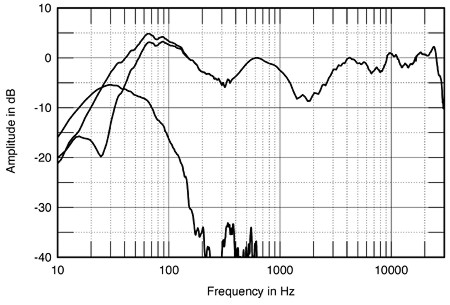| Columns Retired Columns & Blogs |
Coincident Speaker Technology Super Conquest Series II loudspeaker Measurements
Sidebar 3: Measurements
Despite its high specified sensitivity of 92dB/W/m, the Super Conquest came in at an estimated 88.5dB(B)/2.83V/m, which is still on the high side of average. Its impedance (fig.1) ranges between 4 and 9 ohms, with only a moderate phase angle, implying it will be a relatively easy load for an amplifier to drive. The broad saddle at 26Hz in the magnitude trace in the bass indicates the tuning of the reflex port, which, all things being equal, implies good low-frequency extension.

Fig.1 Coincident Super Conquest Series II, electrical impedance (solid) and phase (dashed). (2 ohms/vertical div.)
As well as the step in the traces around 25kHz, which will be due to the metal-dome tweeter's oil-can resonance, slight wrinkles can be seen between 200Hz and 400Hz. These are due to cabinet resonances of various kinds. Fig.2 shows a waterfall plot calculated from the output of a simple plastic-tape accelerometer fastened to the Super Conquest's front baffle just below the nameplate. A very strong resonance can be seen at 266Hz, with others visible at 380Hz and 435Hz. These very lively resonant modes could be detected on all the cabinet surfaces; while predicting their subjective effects is difficult, I suspect they have something to do with KR's problems with the speaker's transparency.

Fig.2 Coincident Super Conquest Series II, cumulative spectral-decay plot of accelerometer output fastened to front baffle below nameplate. (MLS driving voltage to speaker, 7.55V; measurement bandwidth, 2kHz.)
Fig.3 shows the Coincident's frequency response on the tweeter axis at 50", spliced to the nearfield woofer and port responses and their complex sum. The response is significantly unflat; how it affects the speaker's perceived character will depend on whether the listener's ears latch on to the three main peaks or to the dips between them. The lack of energy in the low treble will affect both the listener's perception of dynamics—the speaker needing to be turned for its sound to catch fire—and soundstage, which will be somewhat distant. The midrange just below that region might be heard as a peak, but from his comments I gather that KR was much more bothered by the lack of energy in the lower midrange compared with the regions to either side. Either way, the lack of integration between woofer and midrange needs to be addressed.

Fig.3 Coincident Super Conquest Series II, anechoic response on tweeter axis at 50", averaged across 30 degrees horizontal window and corrected for microphone response, with the nearfield woofer and port responses plotted below 300Hz.
To investigate this further, I measured the electrical drive signals at the three unit's terminals. The result is shown in fig.4. The rolloff slopes are all basically first-order, 6dB/octave, but note the absence of a high-pass filter on the midrange unit. This unit therefore extends down as far as permitted by its subenclosure. A nearfield measurement showed that the midrange driver actually extends to below 200Hz, its response being 6dB down at 105Hz. This significant amount of overlap with the woofer at the top of its passband is going to make integrating the outputs of the two drive-units difficult to achieve.

Fig.4 Coincident Super Conquest Series II, electrical crossver responses, measured at the drive-unit terminals.
This lack of integration can be seen in the lateral dispersion plot (fig.5). The differences in response compared with fig.3 on the woofer side of the enclosure are shown to the rear of the graph, those on the side opposite the woofer to the front of the graph. In fact, the upper-range lack of energy becomes accentuated to the speaker's sides, while the lower-range lack starts to fill in to the sides. The result will be a speaker that is very sensitive to small changes in setup and location. But the off-axis behavior is well controlled higher in frequency, confirming stable imaging (at least in the tweeter's passband).

Fig.5 Coincident Super Conquest Series II, lateral response family at 50", normalized to response on tweeter axis, from back to front: differences in response 90 degrees-5 degrees off-axis on woofer side, reference response, differences in response 5 degrees-90 degrees off-axis on other side of woofer.
Vertically (fig.6), the problem in the midrange/tweeter crossover region worsens below the tweeter axis (which is 35" from the ground), but improves at more than 10 degrees above that axis. This suggests that the tweeter's electrical polarity might be wrong for use with a first-order crossover.

Fig.6 Coincident Super Conquest Series II, vertical response family at 50", from back to front: differences in response 10 degrees-5 degrees above HF axis, reference response, differences in response 5 degrees-10 degrees below HF axis.
In the time domain, the Super Conquest's step response (fig.7) indicates that the tweeter is connected in the same positive polarity as the midrange unit and woofer. The cumulative spectral-decay plot (fig.8) is clean, but the resurgence of energy in the upper crossover region, following the initial suckout in this region, again suggests that the tweeter might work better with its polarity inverted.

Fig.7 Coincident Super Conquest Series II, step response on tweeter axis at 50" (5ms time window, 30kHz bandwidth).

Fig.8 Coincident Super Conquest Series II, cumulative spectral-decay plot at 50" (0.15ms risetime).
Some aspects of the Super Conquest's measured performance are fine, but in several areas I feel there is more to be gleaned from the speaker's obviously good ingredients.—John Atkinson
- Log in or register to post comments




































